Why did my string of holiday lights go out?
Did you ever wonder why one bad bulb can make an entire string of lights go out? It’s all in the electrical wiring!

During the holidays, many people like to be festive decorating with lights – strands of light to be precise. The lights may be wrapped around a tree, framing a door or window, or creating an outdoor scene. Wherever the lights are, it is not uncommon to encounter the dreaded dead strand where one missing or bad bulb makes all the good lights go dark. Why does this happen? Why does one bad bulb ruin it for all the good bulbs? The answer is simple – wiring! There are two common methods to pass electricity for powering multiple units on the same power source. We’ll help explains those differences and just why the whole strand might go bad.
Let’s start with a general definition about electrical systems. When talking about an electrical system, we are talking about an “electric circuit.” The circuit is just a closed loop with a power supply – a battery is a good example – to provide a “current” of electricity, something to transport the electric current, like copper wire, and something or things that receive the charge, such as a lightbulb. If something is taken out of the loop, like a wire is disconnected, the things receiving the current, for example the lightbulb in this case, will not work. When something is taken out of the loop or connections are blocked, it is considered “open.” Only a “closed conducting loop,” a loop where all the pieces are in place, will allow the current to flow.

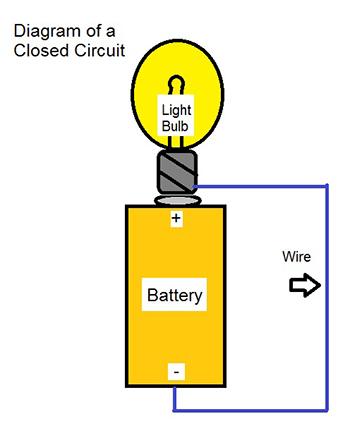
Diagrams of an open circuit (left) and closed circuit (right).
The diagrams above show one “resistor,” which is something like a lightbulb that resists the current flow. Numerous resistors can be on the same power source, much like a string of lights that can be connected in one of two basic ways: series or parallel. When the resistors are connected in series, there is one continuous set of wires that runs the loop from the power source, connecting all the resistors, and back to the power source. If one of the resistors fails or is removed, the circuit is now open, current flow is disturbed and none of the resistors will work. This is why one bad, loose or missing lightbulb will make the whole string go dark!
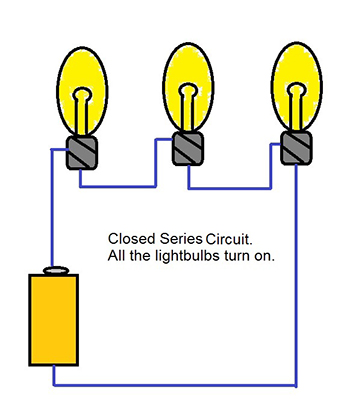
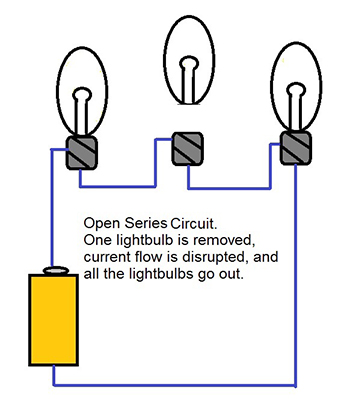
The diagram to the left shows a closed series circuit - all the lightbulbs turn on. The diagram to the right shows an open series circuit. Once lightbulb is removed, current flow is disrupted and all the lightbulbs go out.
In parallel circuits, each resistor or lightbulb has its own separate connection to the power source. This ensures that if one of the resistors goes bad, the others will continue to work because they all have their own independent power supply. The flow of current is not disrupted in this type of circuit.
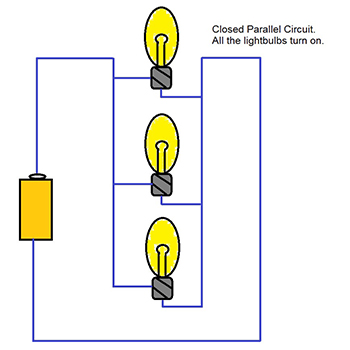
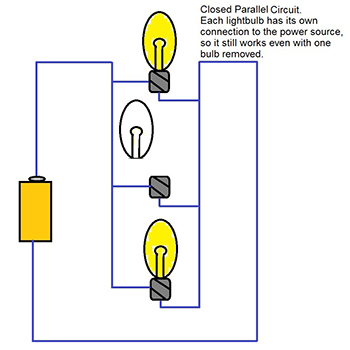
The diagram to the left shows a closed parallel circuit - all the lightbulbs turn on. The diagram on the right shows a closed parallel circuit. Each lightbulb has its own connection to the power source, so it still works even with one bulb removed.
In thinking about circuit designs, why might one be chosen over another? Why do you think series circuits are used in string lights rather than parallel circuits? Can you think of other places you see series circuits are used? Where might parallel circuits be used? Science is asking questions and discovering answers.
For more information and experiments on electricity and other fun topics in physics, check out the Physics Classroom. Now that you know about electricity and why an entire string of holiday lights go out when just one bulb is bad, share the gift of knowledge of what you have learned with others experiencing the same frustration.
Michigan State University Extension 4-H Science and Technology programming offers many educational opportunities. Science activities provide children with life skill lessons in problem solving, critical thinking and decision making. The hands-on experiential learning is fun and educational. When participating in these types of activities, youth develop science, technology, engineering, mathematics and creative skills. For more information about 4-H learning opportunities and other 4-H programs, contact your local MSU Extension county office.



 Print
Print Email
Email




